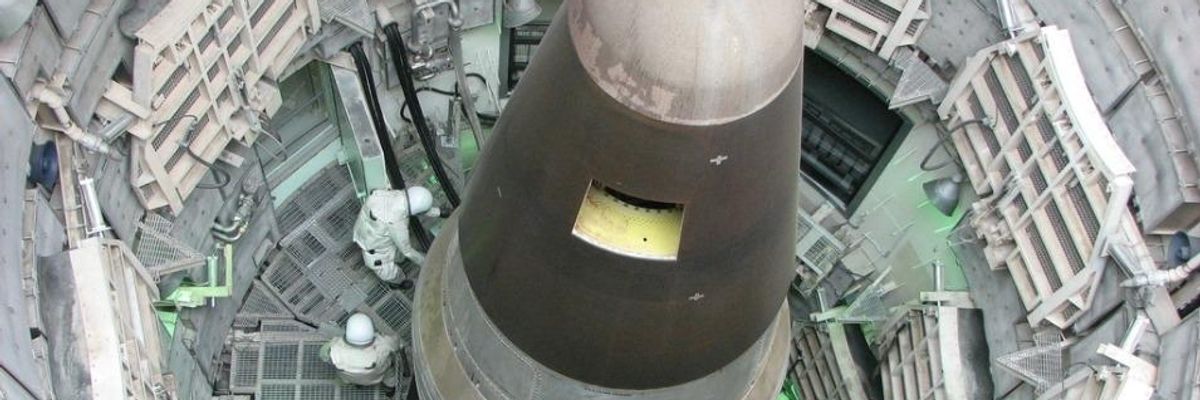Nuclear weapons have threatened humanity for 72 years ultimately becoming the greatest eminent threat to our survival. This past Friday, July 7, nuclear weapons at long last joined the ranks of other weapons of mass destruction including biologic and chemical weapons, landmines and cluster munitions in being banned and declared illegal under international treaty law.
"The adopted Treaty bans nuclear weapons and establishes a framework to mount an effective legal, political, economic, and social challenge to the concept, policies, and practices of nuclear 'deterrence' and to the existence of nuclear weapons themselves in order to eliminate them and all related programs."
The U.N. adopted the Treaty on the Prohibition of Nuclear Weapons. Under Article 6 of the Treaty, states are prohibited from developing, testing, producing, manufacturing, acquiring, possessing, stockpiling, transferring, deploying, stationing, using or threatening to use nuclear weapons, under any circumstances. It also makes it illegal to assist, encourage or induce, in any way, anyone to engage in any activity prohibited to a state party under this treaty, extending the prohibitions to non-state actors as well.
While nuclear weapons still exist, any nation that violates the above conditions will now be in breach of international and humanitarian law and should be considered a pariah state and ultimately on the wrong side of history. As with other weapons of mass destruction, the weapons are usually banned and then subsequently eliminated. .
This historic effort establishes a new norm and when in force will be the law of the land. This Treaty has been years in the making and comes from the convergence of the failure of the nuclear weapons states to meet their legally binding obligation for 47 years, under article 6 of the Nuclear Non-Proliferation Treaty (NPT) to work in good faith to eliminate nuclear weapons and recent scientific evidence demonstrating humanitarian consequences far worse than previously imagined of even a small limited regional nuclear war. Such a scenario would put much of humanity at risk from the associated climate change and nuclear famine that would follow, lasting decades into the future. The humanitarian case has taken this treaty process forward from meetings in Oslo, Mexico and Vienna to the United Nations who gave approval last December for the treaty to be negotiated this year. The process has been driven forward by the International Campaign to Abolish Nuclear Weapons (ICAN) working with civil society. Representatives of 129 non-nuclear nations including the International Red Cross and the Holy See have worked together and made clear through this treaty that they will no longer be held hostage or bullied by the nuclear nations. While there is not one fewer nuclear weapon on the planet, this treaty focuses the world's attention on the nuclear powers and the international institutions that make the existence of these weapons possible. It highlights the humanitarian costs to victims particularly indigenous peoples, women and girls, the hibakusha as well as the catastrophic effects on the environment that have long been the silent victims of the testing, development and use of these weapons.
The treaty adopted by an overwhelming majority of 122 in favor and 1 against, the Netherlands, and 1 abstention Singapore establishes a new international norm and does not specifically establish enforcement mechanism's which are otherwise left to the court of public opinion and adherence to international norms. This does not differ from other international treaties banning weapons of mass destruction such as chemical weapons, biological weapons, and land mines.
"In the future when the United States and other nuclear states are asked, what did we do when our planet was threatened, what will be our response?"
This treaty process has been boycotted by the nuclear weapons states. In particular protestations of the United States and followed suit by Russia who together possess approximately 93% of the 15,000 weapons in today's global arsenals and who have effectively bullied the other nuclear nations with their rhetorical double speak. Voicing their support for a world without nuclear weapons they professed the need to be realistic due to the dangers of these weapons and the need for a strong deterrence thus precluding their ability to participate in this treaty process. They have remained oblivious and hostage themselves to this mythological deterrence argument that has been the principal driver of the arms race since its inception, including the current new arms race initiated by the United States with a proposal to spend $1 trillion in the next three decades to rebuild our nuclear arsenals. Under these deterrence theories, each nation must maintain a superiority or generational advantage over its adversaries thus fueling the ever accelerating and growing arms race to oblivion.
The adopted Treaty bans nuclear weapons and establishes a framework to mount an effective legal, political, economic, and social challenge to the concept, policies, and practices of nuclear "deterrence" and to the existence of nuclear weapons themselves in order to eliminate them and all related programs. The Treaty will be open for signature to all States of the United Nations on September 19 at the U.N. The Treaty shall enter into force 90 days after the 50th State has ratified, signed or accepted it.
This Treaty represents the resolve of the negotiating states and civil society and puts us on a path to a nuclear weapon free world. In the future when the United States and other nuclear states are asked, what did we do when our planet was threatened, what will be our response? What will we say when it is recognized that we were on the wrong side of history and our very survival was threatened?

